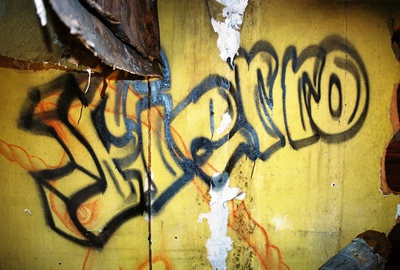
Yesterday’s post on the ghost town of Fierro, NM was heavily historical. In the introduction, I painted a portrait of Fierro as entirely vacant, quiet as a stone, a place where humans rarely tread these days. While that is relatively true, it’s not the entire picture, even aside from services at St. Anthony’s Mission Catholic Church and the occasional family reunion. Fierro does get visited and, judging by the evidence, its visitors are an interesting bunch. So, I thought it would be worth taking a look at who’s been there recently and what they’ve left behind. There might even be something here that'd be useful to know if you’re thinking of making the trip yourself.
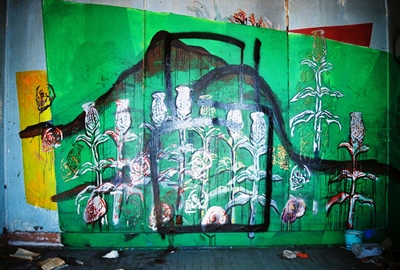
Most of the graffiti in Fierro is in the house shown at bottom, which was last owned by the Araujo family, who also operated Araujo’s Grocery in the building next door.
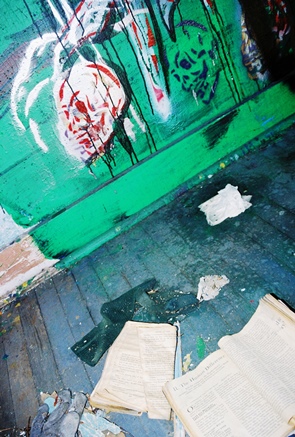 The Araujo’s rented the home out, but one person that probably didn’t sign a lease was whoever painted the green wall of skulls and maize set against the backdrop of a mountain shown above. The artist clearly spent some time in Fierro and, in fact, the room was swept clean and full of the evidence of a fairly prolonged stay. That evidence included some unusual reading material, such as a book about the influence of computers on society which lay open to a chapter titled, “The Human Difference.”
The Araujo’s rented the home out, but one person that probably didn’t sign a lease was whoever painted the green wall of skulls and maize set against the backdrop of a mountain shown above. The artist clearly spent some time in Fierro and, in fact, the room was swept clean and full of the evidence of a fairly prolonged stay. That evidence included some unusual reading material, such as a book about the influence of computers on society which lay open to a chapter titled, “The Human Difference.”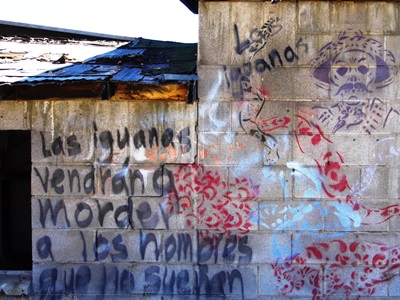
Judging by the stencils, it’s possible the same person wrote this stanza on the back of Araujo’s Grocery itself: Las igyanas (sic) vendrán a morder a los hombres que no sueñan. This is a slight rearranging of a line from Federico Garcia Lorca’s poem, Ciudad sin sueño (Nocturno del Brooklyn Bridge), written in 1929-1930. The translation is: “Iguanas will come to bite the men who do not dream.” Lorca’s work is often pretty surrealistic, but, to me, he is inciting his reader NOT to sleep, but to do, in which case being bitten by iguanas is, in fact, a worthy and motivating experience.
Lorca was executed by a firing squad loyal to Spanish fascist dictator Francisco Franco in 1936, and appears in The Clash tune Spanish Bombs. (“Federico Lorca is dead and gone.”) The Pogues composed an entire song to him, "Lorca’s Novena," in which his corpse walks away. Seeing Lorca’s words as graffiti in a ghost town is quite rare.
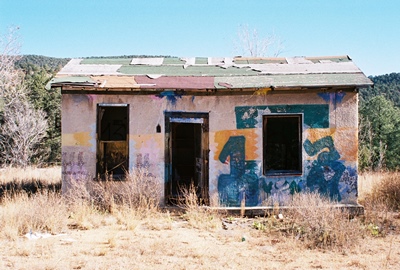
Other visitors to Fierro would seem to include members of Sur 13, the Sureños, a prison gang allied with the Mexican Mafia, MS-13, and the Crips. Their tag is visible in the shot above, as well as elsewhere inside the house.
So, while for many ghost towns it is their history that compels, it’s also true that these places have a present and a population of sorts, even if transient. As always, it is only the future which remains uncertain.
Lorca was executed with a pistol up his ass. sorry.
ReplyDeleteI think it's long been most commonly thought that Lorca was killed by a fascist firing squad, although that has never been truly substantiated.
ReplyDeleteHowever, according to the UK Guardian, official documents just uncovered seem to point to Lorca being arrested and taken by car to a secluded area with one other detainee. He was then “executed immediately after having confessed, and was buried in that location, in a very shallow grave, in a ravine.” No details were included about the exact nature of his execution nor confession and his grave site is still unknown.
The Pogues, of course, do hold by the "pistol up his ass" idea. JM